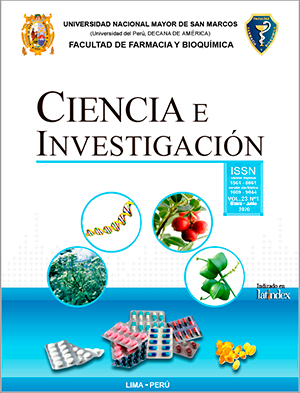In vitro antagonic capacity evaluation of Trichoderma spp strains against Phytophthora cinnamomi, phytopathogen of Persea americana (Palta)
DOI:
https://doi.org/10.15381/ci.v23i1.18754Keywords:
Phytophthora cinnamomi, antagonism, phytopathogen, Trichoderma spp, biocontrolAbstract
Phytophthora cinnamomi is a phytopathogen reported as the causative agent of avocado root rot in Peru. In this study, the antagonistic capacity of Trichoderma spp native strains isolated from the avocado crop rhizosphere in Quilmaná, Cañete, was evaluated. For the in vitro evaluation of the antagonistic capacity of the isolated strains, the dual culture technique was used, where the percentages of radial growth inhibition (PICR) of P. cinnamomi were measured. Of the total isolates, 3 strains (P1.1, P4.9 and P5.3) presented higher PICR with 53.86, 56.24 and 60.49% respectively. Molecular identification indicated that strains P4.9 and P1.1 show 99.66 and 100% similarity to Trichoderma asperellum, while strain P5.3, 98.17% similarity to Trichoderma spp, according to BLAST analysis. Based on the results obtained, these Trichoderma asperellum strains represent a potential to be used as biocontrol agents of P. cinnamomi. therefore, it is recommended to carry out a field trial.
Downloads
Published
Issue
Section
License
Copyright (c) 2020 Ebeling M. Morales T., Mirko D. Lino N., Eddy Ortega R., Pedro L. Castellanos S.

This work is licensed under a Creative Commons Attribution-NonCommercial-ShareAlike 4.0 International License.
LOS AUTORES RETIENEN SUS DERECHOS:
- Los autores retienen sus derechos de marca y patente, y tambien sobre cualquier proceso o procedimiento descrito en el artículo.
- Los autores retienen el derecho de compartir, copiar, distribuir, ejecutar y comunicar públicamente el articulo publicado en la Revista Ciencia e Investigación (por ejemplo, colocarlo en un repositorio institucional o publicarlo en un libro), con un reconocimiento de su publicación inicial en la Revista Ciencia e Investigación.
- Los autores retienen el derecho a hacer una posterior publicación de su trabajo, de utilizar el artículo o cualquier parte de aquel (por ejemplo: una compilación de sus trabajos, notas para conferencias, tesis, o para un libro), siempre que indiquen la fuente de publicación (autores del trabajo, revista, volumen, numero y fecha).






